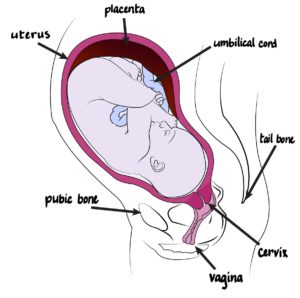If you are pregnant, or hoping to be in the future, you may have begun thinking about childbirth. You may conjure scary images in your mind, or none at all. Because we do not readily discuss childbirth in our culture, there is a big void of information that often gets filled with anxiety and fear. To help, we’re creating a 3-Part Childbirth Preparation Series that will help you understand what happens during labor and offer you simple and tangible tips to more effectively prepare. We partnered with Childbirth Educator and PROnatal Advisory Board member Ashley Brichter, CCCE, CLC of Birthsmarter for this series.
In this first post, we’ll focus on providing an overview of what happens during labor. Then, in the following 2 posts, we’ll break down stages 1 and 2 in more detail — providing you strategies to help you navigate them more successfully.
What Actually Happens During Labor?
What actually happens during labor? You may conjure up images from the movies of a woman’s water breaking (like a gigantic waterfall), the mad dash to the hospital, and then her furious torrent of expletives at her partner in between tiring bouts of pushing. Hollywood drastically misrepresents childbirth, and it does us no favors. While slower, and less dramatic, childbirth in the real world is likely the greatest opportunity pregnant people have to showcase their strength, endurance, and mental fortitude.
Let’s begin with a basic overview of what has to occur to get a baby out of the womb. Take a look at the image below. Babies grow inside a muscular organ called the uterus. The bottom of the uterus is the cervix. Think of the uterus like a garage, and the cervix like the garage doors. The garage doors must open in order to let the baby (or “car” in this analogy) out.

Note the following two things about the image above:
- The cervix is closed here and doesn’t look like it’d be very easy for baby to get out. Therefore, the first part of labor involves the cervix softening and – with the help of uterine contractions – effacing (or thinning) and dilating (or opening) to allow baby to pass through. Under optimal conditions, this occurs physiologically with the release of hormones and the power of uterine contractions.
- The cervical opening (where baby’s head will come through) does not line up with the vaginal opening (where baby must come out of). This means the baby will have to perform a series of movements and rotations to get aligned with the vaginal opening. While this sounds quite complicated, in most cases, babies are actually pre-programmed to do this. Watch this fascinating video on the cardinal movements human babies perform to navigate the complex trip down the birth canal.
So, in short, three things must occur BEFORE pushing begins:
- The cervix must soften to allow the baby to pass through.
- The uterus must contract to push the baby downward and also pull the cervix out of the way.
- The baby must rotate to get aligned with the vaginal opening.
Now let’s dive into the process of how these actions occur during labor. The medical community often breaks the labor process down into three stages. We’ll briefly provide an overview of those stages below, then dive deeper into the first two stages in the following posts.
Stages of Labor (Overview)
Labor is often broken down into the following three stages:
- Stage 1 (Uterine Contractions and Cervical Dilation): This is the stage where the uterus is contracting, and the cervix is softening to allow baby to pass through. When baby’s head presses against the cervix, the pressure causes the cervix to thin, and in turn, causes the uterus to contract. These uterine contractions push the baby downward while also pulling the cervix up and out of the way. Contractions typically start short and mild, and gradually grow longer and (much) stronger. The whole process of Stage 1 labor takes anywhere from a few hours to a few days – and is often longer for first time pregnancies.
- Stage 2 (Delivery of the Baby): Stage 2 is the “pushing stage” (the one we know so well from Hollywood). Pushing can occur once the baby is in position and the cervix is fully dilated (open and out of the way). The length of Stage 2 varies widely by individual. Those giving birth for the first time typically – but not always – have longer Stage 2 labors (up to 2 hours). Those who have had prior births often have shorter Stage 2 labors – even as short as a few minutes. The birthing parent’s position, fetal position, strength, stamina, pushing timing and technique all play a role as well.
- Stage 3 (Delivery of the Placenta): Say what? There’s a stage AFTER the baby comes out? Yes, once the baby has been delivered, and everyone in the room is flooded with elation and emotion, there is one last stage of actually “birthing” the placenta. This entirely new organ, grown to nourish the baby, sometimes comes out with very little effort. Other times it may require work to push it out. Sometimes contractions occur, and other times, they do not. Either way, the placenta is often delivered within a half an hour after childbirth.
So there you have it – childbirth in a nutshell. Before we breakdown Stages 1 and 2 in detail, there is one important factor to discuss that impacts every tip we will share throughout the next two posts. Let’s discuss that first.
Critical Preparation Tip
Many expecting parents spend more time choosing a stroller than choosing the medical professional who will deliver their child. However, the doctor or midwife often has the greatest impact on one’s birth experience. These professionals shape the way their patients think about their bodies, their births, and their babies. So many of the tips we will discuss in the tips for Stage 1 and Stage 2 labor are greatly influenced by the medical provider.
In many cases, pregnant people continue seeing their same OB/GYN simply because they have been with that doctor for years – only to find out much later that the doctor’s approach doesn’t align with their needs or values when it comes to their birth preferences. Start EARLY to find a provider who aligns with your needs and values. To help you in selecting the right provider for you, check out this guide, How to Select Your Ultimate Birth Team, by Birthsmarter.
What’s Next…
Now that you have a basic overview of what happens during childbirth, we’ll move onto breaking down Stage 1 Labor in more detail — providing you strategies to help you navigate this stage more effectively. So, take a few deep (360°) breaths, and let’s discuss Stage 1…
Want Additional Resources?
For additional resources to help you exercise safely and effectively during pregnancy, explore our training programs and services. You’ll find a variety of offerings tailored to different needs — from education, to self-guided programs, to the ability to work with an expert coach.
Or, if you’re a health & fitness pro interested in coaching pre & postnatal clients, check out our ProNatal Education & Certification.
Affiliate Notification
The Birthsmarter Class contains an affiliate link. We may earn a commission from this link, but we only endorse companies that we have vetted and truly believe in.
